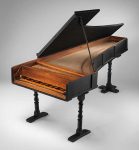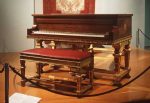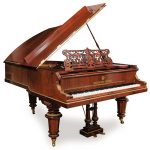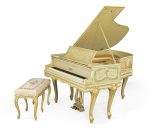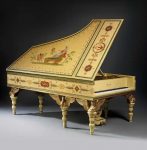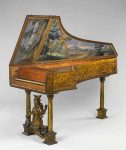Grand Piano,1720 Bartolomeo Cristofori Italian
Bartolomeo Cristofori was the first person to create a successful hammer-action keyboard instrument and, accordingly, deserves to be credited as the inventor of the piano. This example is the oldest of the three extant pianos by Cristofori. About 1700 he began to work on an instrument on which the player could achieve changes in loudness solely by changing the force with which the keys were struck. By 1700 he had made at least one successful instrument, which he called “gravicembalo col piano e forte” (harpsichord with soft and loud). His instrument still generally resembles a harpsichord, though its case is thicker and the quill mechanism has been replaced by a hammer mechanism. Cristofori’s hammer mechanism is so well designed and made that no other of comparable sensitivity and reliability was devised for another seventy-five years. In fact, the highly complex action of the modern piano may be traced directly to his original conception.
Reference: The Metropolitan Museum of Art
Grand pianoforte made by Chappell & Co Made 1915-1916 This concert grand piano by Chappell & Co is an excellent example of high quality piano manufacture and is significant for its uniqueness and rarity. It is likely the instrument was either made as a one-off item commissioned from Chappell or was one of a very limited number of this type that were produced. As such it is a fine representative example of the peak of English piano manufacture during the first two decades of the twentieth century.
Reference: Museum of Applied Art and Sciences
A mahogany, rosewood and ebony boudoir grand piano by DIEDERICHS FRERES ST. PETERSBOURG, circa 1900 serial n° 8558, with a metal frame and ivory keys Haut. 96 cm, larg. 144,5 cm, prof. 177,5 cm ; height 37 3/4 in., width 56 3/4 in., depth 69 3/4 in.
Sold for 18,750 EUR at Sotheby’s in 2019
Square Piano. Case and stand of mahogany, with stringing of boxwood or holly; the sharps are of ebony and the naturals are covered with ivory
IOHANNES CHRISTOPHER ZUMPE LONDINI FECIT 1767 / PRINCESS STREET HANOVER SQUARE
Reference: © Victoria and Albert Museum
A William Knabe and Company Louis XV Style Paint Decorated Small Grand Piano; Together with an Associated Piano Bench Second half 20th century Serial Number 86329. height of piano 40 1/2in (103cm); length 66in (168cm); width 59in (150cm); height of bench 21 1/2in (55.cm); width 36in (91.5cm)
Sold for US$ 2,040 (£ 1,625) inc. premium at Bonhams in 2019
A FRENCH POLYCHROME PAINTED AND PARCEL-GILT GRAND PIANO BY GAVEAU, PARIS, 1924 Painted overall with Neo-Classical musical motifs, the lid finely painted with Venus in her chariot among putti, the reverse further decorated with a floral wreath, the case supported by swans with out-stretched wings above tapering baluster legs, the pedals in the form of a lyre, the soundboard with ‘GAVEAU PARIS’ label, the interior with cut-brass plaque numbered ‘176266’, the keyboard backplate also signed ‘GAVEAU/ PARIS’ 7 ft. (213.5 cm.) high, open; 40 in. (101.5 cm.) high, closed; 8 ft. (204 cm.) long; 48 in. (147.5 cm.) wide
Sold for GBP 52,500 at Christie’s in 2018
